| 1 | Stejneger’s snail sucker |
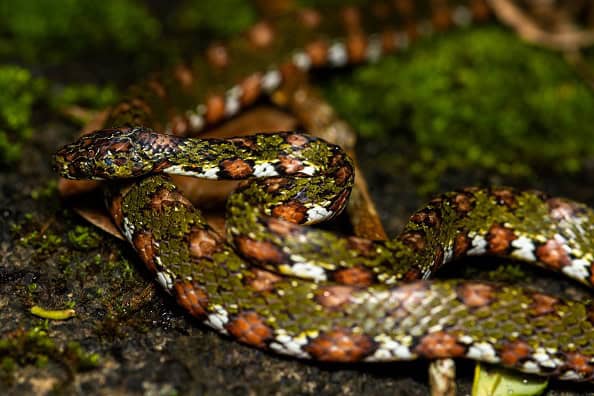
A 35cm (max 62.4cm), branch-dwelling snake which belongs to the 22 member Sibon clan, collectively known as the snail suckers due to their diet, although many also slurp up slugs. Stejneger’s snail sucker (Sibon longifrenis) is a completely harmless if extreme-looking rainforest snake. The overwhelming majority of sightings are in Costa Rica, although there’s a handful over the northern border in Nicaragua, and over the southern border in Panama.
Sibon longifrenis doesn’t just inhabit forests, but prefers the deepest, shadiest forests starved of all light. Habitats of Stejneger’s snail sucker include wet lowland forests, premontane wet forests and rainforests. Most Sibon members have a slightly alien, forested look to them, particularly with their bulging eyes, but Stejneger’s snail sucker is one of the most extreme of all. It seems to be covered in moss, as though the longer it stays in the rainforest, the more it absorbs the essence of that rainforest. Who knows – in 1 million years, the species might just be a mossy branch that bites people.
If this species was dropped in a grassy clearing near a small Costa Rican village, it probably wouldn’t know what to do. It might be unable to find its rainforest home just a few hundred metres away, and die right there. In an arid plain, it would be toast. Stejneger’s snail sucker has adapted to rainforests. It made its choice long ago, and its fate is sealed, for better or worse.
| 2 | Beautiful pitviper |
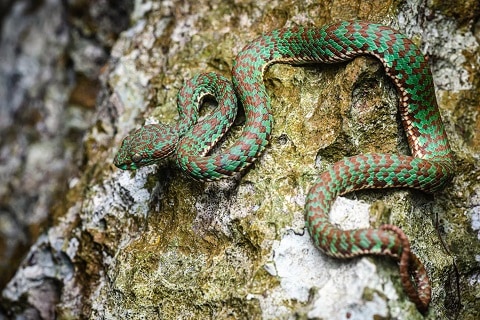
A branch-dwelling pitviper measuring 40-80cm, which both hunts from branches, and launches lunging attacks from branches. They also appear on rain-soaked rocks, as the image above shows, but rarely the ground.
The beautiful pitviper (Trimeresurus venustus) was named for its fantastical colours, which are much more detailed than the plain green of the rest of its Trimeresurus pitviper family. T. venustus is certainly beautiful on the outside, though whether it’s beautiful on the inside is seriously debatable. Its venom primarily contains cytotoxins and haemorrhagins rather than neurotoxins, and rarely kills, but unleashes painful local symptoms.
According to a 2019 report, its venom is middling for the Trimeresurus pitviper family. A 60 year old man was bitten when removing one from a box, and experienced a swelling finger, which spread steadily down his hand. The man was administered antibiotics and analgesics, and there was little coagulopathy or bleeding, but it could have been worse without medical treatment. The man was discharged from hospital within 26 hours, but if you’re in the beautiful pitviper’s domain, the rainforest, the story could be very difficult, particularly if you’re bitten on the trail at the furthest distance from your car.
Exactly how many live in Thailand’s rainforests is debatable. We know they inhabit a relatively narrow region, specifically the southern provinces of Thailand north of the Malaysian border. They also have an isolated population on the Malaysian island of Langkawi. But within that range, there could be tens of thousands of beautiful pitvipers, plotting your demise, or maybe minding their own business – we lack the technology to read their minds right now.
| 3 | Vermiculate snail eater |
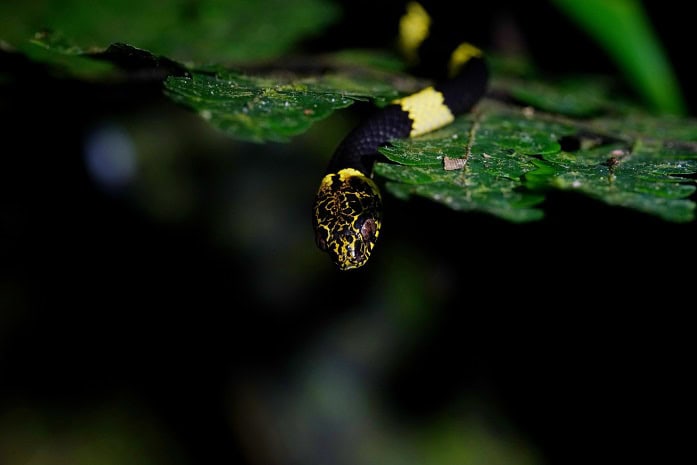
The Dipsas clan is the other major snail-eating clan of South and Central America, containing over 30 members, all harmless to human beings. The Vermiculate snail-eater (Dipsas vermiculata) resides in the Eucadorian Amazon, east of the Andes, and measures 60-70cm. This species never attacks humans, preferring to release a foul smell or triangulate its head to mimic a viper. They lack offensive weapons, yet are plentiful in eastern Ecuador, and are clearly effective at surviving in the competitive rainforest world.
In a parched arid plain or somebody’s backgarden, this snake would stand out instantly. But when you’re in a rainforest where every lifeform glows with neon fluorescence and practically resembles an alien life form, funky colours are exactly what you need to blend in. Vermiculate snail-eaters also appear in northern Peru, and have been found at altitudes from 210–1690 metres.
In the complex rainforest world, every branch, stem or dangling vine represents an opportunity for this snake. They’re light enough to weave along even the most delicate of vegetation, typically staying 1-2 metres above ground. Slugs and their snails are brought out by rainfall, meaning that wet weather is a godsend to this snake, and in the rainforests of eastern Ecuador, they rarely have to wait long.
| 4 | Butterfly viper |
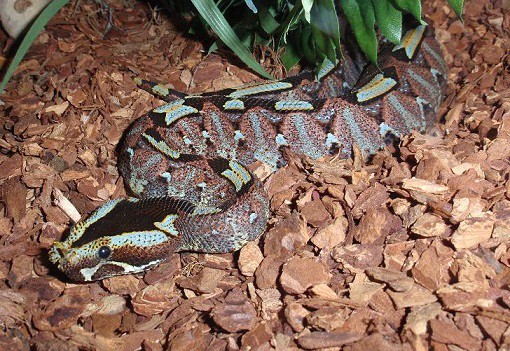
Butterfly vipers measure 80-100cm and are a thick tank of a snake found mainly in central African rainforests, including Uganda, DRC and Rwanda. They’re the most fantastically coloured of the Bitis adder family, which has 18 members in sub-Saharan Africa. Puff adders are the most common but are far duller, mainly beige and black. That’s because they mainly inhabit more open areas next to foressts, like grassy overgrown game trails, while butterfly vipers prefer to lurk in the depths of the rainforest. Sailing down Congo rainforest rivers and scanning the rivershore is a way to spot them, although by doing this you might not notice the hungry Nile crocodile lunging at you from behind.
Butterfly vipers look like they’re covered with poisonous fungi, and if you ate one you’d probably die just the same. This isn’t a meal you should choose if you’re lost in the Ugandan rainforest by a dying campfire, with no hope of escape.
If you meet a butterfly viper while stumbling around, you’re quite likely to survive, as they’re a sluggish slow-moving snake. They won’t charge you down like a cobra, and the tangled rainforest foliage is too thick to do so anyway. The problem is their immense camouflage, which makes seeing them impossible. You’re likely to brush against, walk 1 metre from, or even step on a butterfly viper, which it won’t take kindly to, particularly given that you’re invading its personal rainforest domain, and not sticking to towns and cities.
While more African locals have doubtlessly died without being recorded, butterfly viper bites have only caused one confirmed death, a 48 year old firefighter from Dayton, Ohio who kept one as a pet, and died in 2003.
| 5 | Fire-bellied snake |
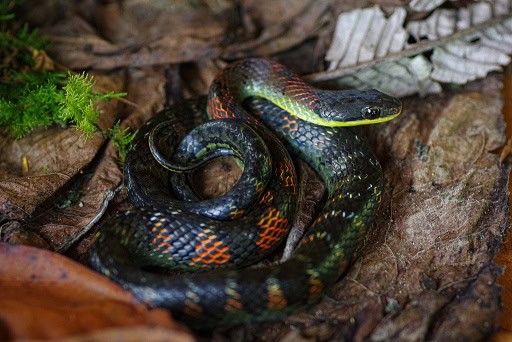
A 45-80cm species mainly found in watery zones within rainforests. Fire-bellied snakes are the masters of subtle rainforest shades. This species lives in Colombia, Costa Rica, Panama, western Ecuador – anywhere west of the Andes mountain range. Compared to their Erythrolamprus cousins like the yellow-bellied liophis, which inhabit water bodies in regular forests, this species has ventured into the crawling humid pits of rainforests, never to return. Consequently, their patterns have grown far funkier over the years.
The fire-bellied snake (Erythrolamprus epinephalus) does have a venom but is relatively harmless. One of their coolest skills is enlarging their neck sideways like a cobra. Various Erythrolamprus members (there’s 55 members in total) have this power, but it’s most consistently observed in fire-bellied snakes. They share no relation or geography with cobras, so they evolved the skill completely independently.
Another skill is being able to prey on the poisonous golden poison dart frog, which would leave a human writhing on the ground in death throes, but has no effect on the fire-bellied snake. Living in a rainforest forces you to adapt to the rainforest and all its lethal, dangerous obstacles. It’s possible that dart frogs are now working out a subtle alteration to their poison in response. The arms race is neverending in the rainforests of South America.
| 6 | Tropical flat snake |
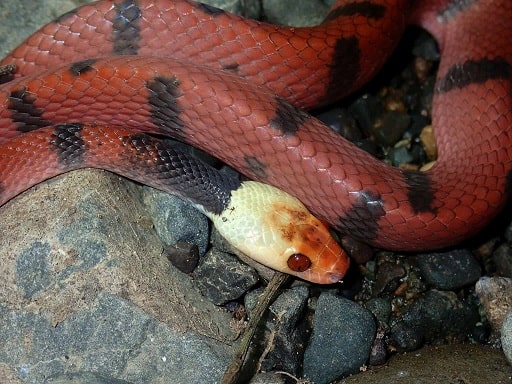
This rainforest species is also known as the red-eyed tree snake or mapepire de fe by locals. It’s a mostly harmless species measuring 65-120cm, whose venom probably only causes a slight stinging in human beings. Instead, its venom is targeted towards its mainly reptile prey, which includes green iguanas, common basilisks (not the snake), common stream lizards, lava lizards, and possibly rare rainforest anoles which the human race hasn’t identified yet, but have nevertheless existed for millions of years.
Siphlophis compressus looks like the guardian of the rainforest which activates with a sudden reddening of its eyes, and begins a relentless search for you the moment you set foot across the border into its land. It has some of the reddest eyes of any snake, yet don’t mistake this for an evil personality, as you can easily walk past this snake safely while lost in the rainforest (though the same cannot be said for poison arrow frogs).
Tropical flat snakes are most likely to be found on branches within rainforests, but don’t stick to this rule religiously. In a 2015 encounter, this snake reacted when humans approached by shifting its skull into a triangular shape. Several minutes later, it hid its head under its body fearfully.
| 7 | Chocoan toad-headed pitviper |
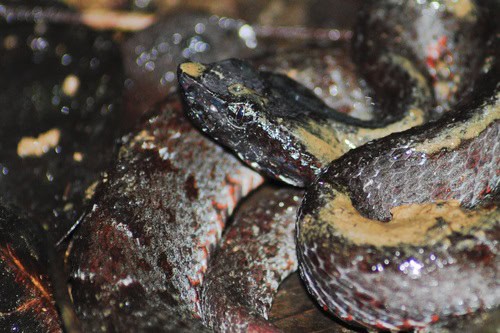
A 45cm (max 76cm) venomous species which mainly grinds along the ground in rainforests, rather than resting on branches. This snake is severely dangerous, but lives in narrow, humid, dense and overgrown section of rainforest tucked away in the west of Colombia, so is rarely encountered by mankind. The Chocoan toad-headed pitviper (Bothrocophias myersi) is a true rainforest snake, as it is only found in areas receiving 5000mm of rainfall annually (London receives 585mm).
Once upon a time, Bothrocophias myersi shared a common ancestor with the Crotalus clan of rattlesnakes, but their paths wildly diverged. The rattlesnakes headed for the dusty arid badlands of Mexico, turning pale and rattling their tail menacingly at any large animal that strayed past. The toad-headed pitviper entered the rainforests, and sank ever deeper into a quagmire of swamps, poisonous frogs, dangling vines, and swirling clouds of mist.
Bothrocophias myersi lives in such inhospitable rainforests that it was only discovered in 2001. The first study on its venom came in 2020, and found that it had weaker haemorrhagic and coagulant abilities than nearby Bothrops lanceheads. However, it was especially skillful at causing muscle tissue damage (myotoxicity), as evidenced by a rise in bloodstream creatine kinase. Two antivenoms were tested, and the Costa Rican was significantly weaker than the Colombian vial.
| 8 | Northern woodland racer |
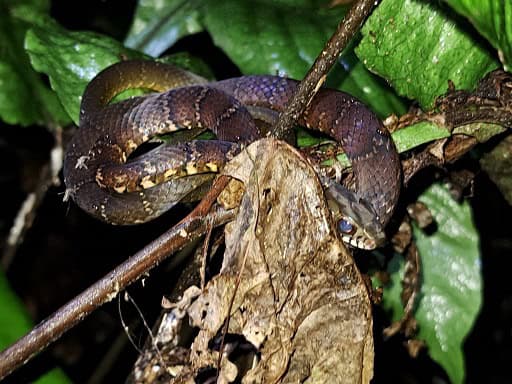
The Northern woodland racer (Drymoluber dichrous) has a misleading name. Firstly, it’s found across the entire Amazon region, not just the north. Secondly, it doesn’t just inhabit woodlands; it prefers the most humid, stifling jungles. This is a diurnal (day-faring) snake which measures 100-110cm and mainly sticks to the ground, rather than resting on branches.
It preys on a mixture of reptiles and frogs, including the giant ameiva, striped forest whiptail (Kentropyx calcarata), and slender anole (Anolis fuscoauratus). The northern woodland racer is a manual hunter, utilising neither pulsating venom nor stealthy ambush. Instead, it prowls the forest floor and creeps up slowly on any reptiles it spots. At the last second, it performs a sudden acceleration and charges its prey down, making a well-practised grab.
This isn’t a superpowered snake but its well-honed hunting techniques are enough to guarantee it survival in the competitive Amazon rainforest. This is an extremely widespread species, which ranges from Brazil to Ecuador to Suriname to Colombia.
| 9 | Black-skinned parrot snake |
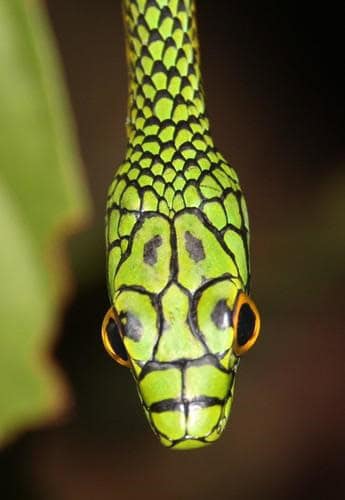
This long, thin species averages at 60-100cm, and is primarily found in the rainforests of eastern Ecuador and Peru, with occasional sightings in Brazil. The black-skinned parrot snake mainly sticks to tree branches, where its light weight enables it to move through the rainforest canopy with ease, whereas a boa constrictor would be halting and clumsy.
Unlike humans, this snake is unable to drive a car or fire a machine gun, but there’s one thing they’re clearly better at than us – surviving in inhospitable rainforests. As you can see from the image, its eyes are enormous. The parrot snake’s bulging eyes help it in the complex rainforest environment where every subtle movement and every unexplained flash of red could mean something. Its prey includes turniptail geckos (Thecadactylus rapicauda), anoles and poisonous Osteocephalus spinyback treefrogs.
This version differentiates from other parrot snakes by its black outline to each green scale. Leptophis nigromarginatus only became an official species in 2022 as it was originally considered to be a species of the main parrot snake (Leptophis ahateulla). There was so much genetic variation across the different rainforest regions and misty valleys and humid mountain forests of South America that there were clearly several hidden species hidden in one, and this was elevated to independence alongside Leptophis dibernardoi of Brazil.
| 10 | Crowned false boa |
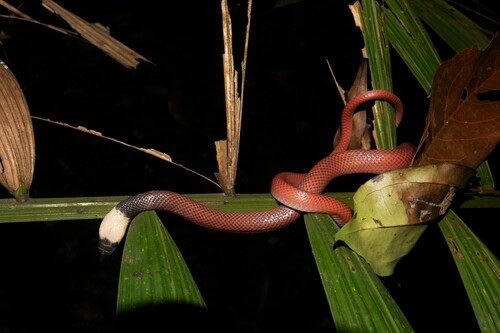
A little known yet very widespread species in the Amazon rainforest region. The crowned false boa (Pseudoboa coronata) lacks a mind-melting venom or a ferociously aggressive personality, yet they have fought for and maintained their rightful place in the rainforest hierarchy. This species peaks at 109cm, and is found from Ecuador in the west to Suriname in the east, while covering the entire Brazilian Amazon inbetween.
Although they’re perfectly comfortable in humid, stifling rainforest, crowned false boas also appear in clearings and disturbed forests, perhaps even villages adjacent to rainforests. They prefer on a variety of animal groups, including black-headed centipede snakes, swamp eels and giant ameivas. They’re active during both day and night. In fact, flexibility is the reason they’ve survived so well and actually become more common than pulsatingly venomous creatures like the Chocoan toad-headed pitviper, which appears in one treacherous but thankfully small slice of nightmarish rainforest.
Crowned false boas are never a dull snake. They typically have a juicy red body like above, with a snowy white neck and sudden transition to a black face. In some, the snowy white neck is missing, while their belly is nearly always a snowy white, and their pupils are black and round.
